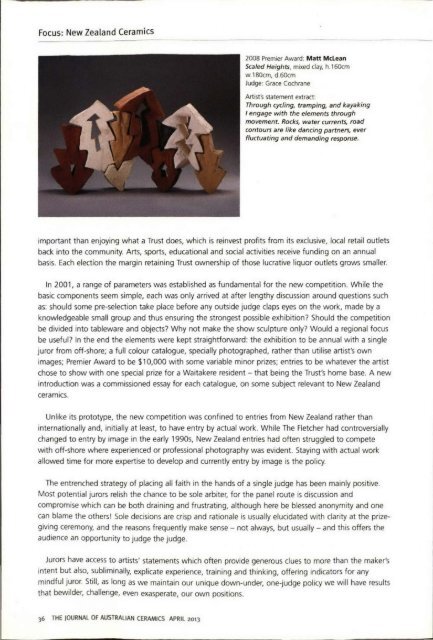The Journal of Australian Ceramics Vol 52 No 1 April 2013
You also want an ePaper? Increase the reach of your titles
YUMPU automatically turns print PDFs into web optimized ePapers that Google loves.
Focus: New Zealand <strong>Ceramics</strong><br />
--------<br />
2005 Premier Award: Merilyn Wiseman. Arctic Rim, earthenware, h.43cm, w.11Ocm. d.27cm<br />
Judge: Robert Bell<br />
Artist's statement extract: <strong>The</strong> naming <strong>of</strong> a work brings its difficulties, as do too many words <strong>of</strong><br />
explanation ... , prefer to allow the work to speak for itself. <strong>The</strong> Utle is intended to act as a<br />
trigger to activate dialogue.<br />
<strong>The</strong> Fletcher Challenge <strong>Ceramics</strong> Award's demise in 1998 presented a gap that was difficult to fill as<br />
it became clear that more than a competition was in peril. By then there were many other competitions,<br />
although none carried the same cachet or the rewards. <strong>The</strong> real void comprised withdrawals <strong>of</strong> a<br />
variety <strong>of</strong> specialist retail venues that steadily changed focus or closed doors from the late 1980s as<br />
progressively lifted import restrictions allowed in competitive ceramics. A corollary to this meant one<br />
after another tertiary programs removed ceramics from their <strong>of</strong>ferings as students turned to what<br />
seemed more rewarding courses in the shrinking retail and exhibiting environment. When courses were<br />
retained they went under the heading <strong>of</strong> Visual Arts and were part <strong>of</strong> a wider, more generalised arts<br />
program that might include clay, but only under a fine arts rubric and with no cognisance to ceramics'<br />
particular and rich histories.<br />
<strong>The</strong> vacuum has been partially filled by Distance Learning Courses <strong>of</strong>fered via local pottery societies<br />
that resource from Otago Polytechnic. <strong>The</strong>se courses <strong>of</strong>fer a certificate and a diploma but no degree<br />
qualification. Results vary enormously, depending on who can be found to teach in the region, but it's a<br />
chalk and cheese affair when compared with a well-resourced tertiary program.<br />
When Garth Clark was in New Zealand in 2006, he talked about how, in America, ceramics had<br />
settled into two layers. One was essentially taken up by major public and white cube galleries while<br />
the other operated at local and regional level and was active in craft fairs and direct sales <strong>of</strong> various<br />
kinds. What had been in between, the specialist craft gallery and regionally focussed publicly funded<br />
institutions where craft media work was exhibited as such, had for the most part departed from that<br />
purpose or disappeared. <strong>The</strong> first category was small and particular, while the second was still large and<br />
active, but aging.<br />
While Clark's somewhat sweeping generalisations seemed a tad extreme at the time, I have since<br />
realised that much the same has happened here, albeit in our own small way with our own small<br />
community. <strong>The</strong>re are a few whose work has been taken up by white cube spaces who enjoy what<br />
such venues can <strong>of</strong>fer and comply with what such venues expect. Most have no regular gallery and<br />
34 THE JOURNAL OF AUSTRALIAN CERAMICS APRil <strong>2013</strong>

















